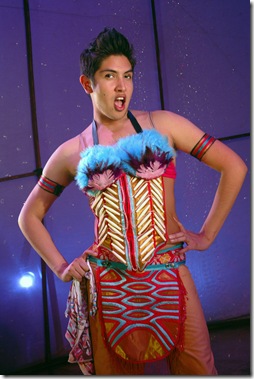Agokwe : the staging makes the show!
Agokwe is written and performed by Waawaaté Fobister who very clearly benefitted from the superlative Buddies in Bad Times production values because the staging is what really makes this show.
Visually it is very strong. Behind this performance lies an excellent team composed of Andy Moro’s striking graphics and projected designs, Erika Iserhoff’s beautiful costumes – especially the raven who stole the show- Lyon Smith’s otherworld sound design and Kimberly Purtell’s magic lighting. Last but certainly not least is the contribution of director and dramaturg Ed Roy who worked on the text and orchestrated the gestures, the movements and the way that Fobister’s story telling unfolds on stage.
The play becomes a true ritual of transformation, aimed at correcting the thinking of those ‘stupid humans’ who are destroying this planet. They must be made into a more understanding community of individuals who will earn to love each other. The performance is therefore almost a form of mental therapy whose aim is to change Native people’s attitudes about gays, lesbians and Queer culture in general. There is therefore a real social question addressed by this performance, but it is also a fun filled amalgamation of performance styles that sets the show off on highly theatricalized and definitely entertaining track which perhaps also reveals one of the weaknesses in this work. .
First there is Waawaaté Fobister’s striking entrance. He flutters down to earth in the body of a raven, flapping his wings and cocking his head. He is actually the Ojibway trickster Nanabush- the one we see so often in Native theatre because, like the Shaman, not only does he connect the visible and the invisible worlds, but he is also the very essence of theatre itself because Nanabush epitomizes constant transformation, the assuming of multiple shapes, multiple sexual identities, and a great variety of roles. The main difference however, is that Nanabush has powers and can act upon reality. Agokwe is based on that assumption.
Thus, Nanabush attracts our attention by telling us the story of Jakey and Mikey, two boys who discover their sexuality that they never dared to admit, because of the hostility to such things in their own communities. They realize that they are ‘Agokwe’, the Anishinaabe word for someone who harbours both the male and female presence within, the word that gives its title to the play.
This whole theatrical event is therefore done by an ever changing Nanabush, doing her/his theatre performance in a highly gay mode: shifting identities and changing acting styles. He/she turns into a provocative carabet style drag queen that plays up to the audience, showing her wares and strutting around the stage in campy fashion. He also becomes a story teller who assumes the various characters in his story- both male and female. It’s a fun filled but very difficult mixture of cabaret, stand-up comedy, campy humour, traditional storytelling and stagey mimicry. If the story of these young people seems a bit simplistic and déjà vu, it’s only because it emphasizes the youth of the story teller and the fact that it has to be taken as a parable, a story meant to teach an idea and transform all those within the community who don’t understand what being ‘Agokwe’ really means.
However, what kept nagging at me during the show is the fact that it quickly became obvious that Fobister is not a particularly good actor. It is of course understandable. He is very young and this is an extraordinarily demanding role with all the shape shifting acrobatics it involves. Fobister appeared to be completely at home as a campy stand-up comic making queer jokes. But he is not yet at ease as an actor. He still has to work very hard to go beyond that stand up level of performance. I got the sense that every one of his moves was tightly choreographed by director Ed Roy. Nothing was spontaneous. Nothing came from within. Without Roy’s close work, this stage event would not have materialized.
Still the Nanabush visuals and all the designs that surround the circular performance pedestal carry us into another world where we are caught up in this very non-traditional reading of ritual, and the campy Nanabush was delightful to watch. It was beautiful, it was fun and there were even rather touching moments in the story if you allowed yourself to enter into the dance and be properly seduced.
Agokwe plays until February 12, in the Studio of the NAC.
Alvina Ruprecht, Ottawa
January 7, 2011
